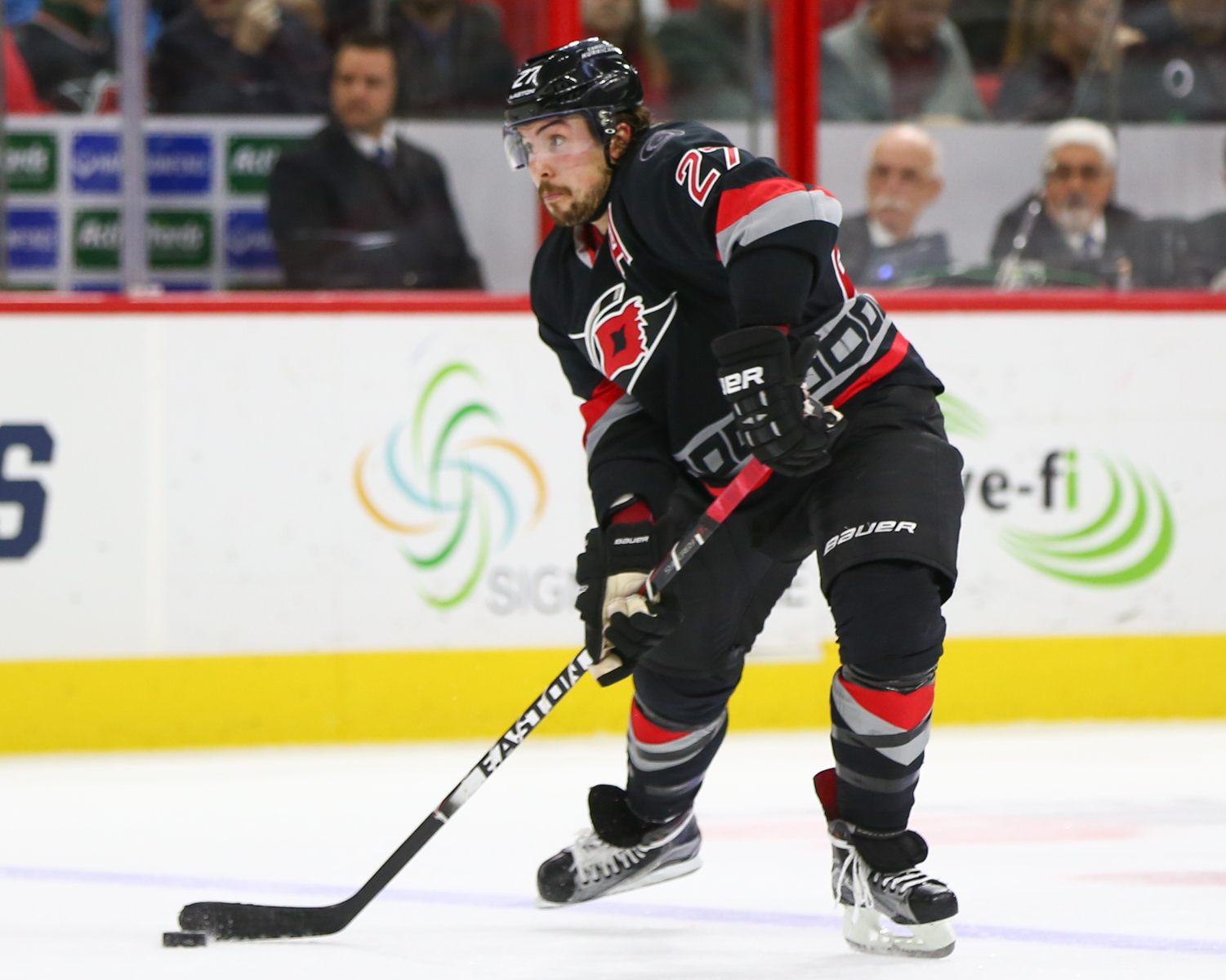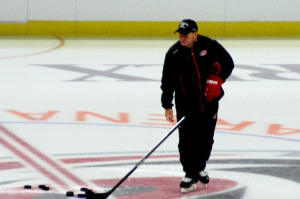

By Peter Koutroumpis
RALEIGH, N.C. – Fitting in is important to the success of any group in any setting.
At PNC Arena last weekend, the start of training camp reestablished the connections among Carolina Hurricanes players who once again began working together to mesh and intertwine more closely with the upcoming season approaching.
It was a glaring sight watching two, fast-moving groups hustling and deeply carving ice with so much energy.
You’ll get that when the majority are in the under-25 age range.
Skewing the age level lower is the influx of nearly three dozen born after 1992 – mostly unproven, prospects from recent draft years who seek to show that they can be part of the established group.
That is a defining difference of what the Hurricanes are today compared to three, five, and even seven years ago.
Journeyman free agents are less the offseason pickups now compared to signed prospects starting their entry-level contracts.
It’s almost to a point of an embarrassment of the potential riches that executive vice president Ron Francis has assembled in the ‘pieces’ or ‘assets’ Carolina currently possesses.
However, as the team’s second and third waves of draft classes enter camp, their immediate futures are more defined.
They’ll get looks during the current preseason in which the Hurricanes are 2-1 after rotating the original camp roster of 59 into all three contests.
While some small rounds of cuts have been made, the bigger slices will come within the coming days.
The odds of any of the team’s higher picks making the NHL squad are slim – a lot slimmer than when now veterans like Jeff Skinner, Justin Faulk, Elias Lindholm, to name a few, were skating in their first or second camps.
Carolina is poised to make it’s best run at a playoff spot than it has for a long time, and the need to push inexperienced talent into the fold isn’t as desperate.
The veterans are young and have been fortunate to establish the base of what head coach Bill Peters’ system relies upon, so the need to solidify that group is important heading into the fourth year of his tenure.
Faulk concurred on that point.
“It’s important I think…you wanna be comfortable with each other in the room, have a good feeling for each other out on the ice, off the ice, whatever it might be, and have that bond as a group,” he said.
“Obviously, the more time you spend together, the better that becomes, and the stronger that becomes. We’ve had a lot of turnover in the past, but the last couple of years it’s been certain to have a lot more guys be the same, and add just a few guys in and out. So, it’s starting to be at a point to start putting it together as a group, and make the next step and find ourselves in the playoffs come April.”
That possibility should excite faithful fans who have supported a younger group more positively despite Carolina’s shortcomings in failing to reach the postseason for eight straight years, the league’s longest active drought.
What are the chances top picks like Julien Gauthier, or Martin Necas, the Hurricanes’ most recent head of the 2017 class, earn NHL playing time this season?
The simple answer is they have less of a chance than five years ago, but it’s not out of the question – the ‘never say never mindset’ or reality of the NHL always exist.
“You can go both ways,” Faulk said.
“As a young guy, if the team’s not doing too well, there’s more opportunities for you to come in and crack the lineup and get a better or longer look. But at the same time, at the other end of things, if the team’s in a strong position, and you do get that opportunity to come into a successful team, you can look around – this team’s had success in generating players, and find themselves in better positions. Knowing that you’re comin’ into a good organization that has depth and puts players through the process, when they get here, they’re ready, not rushed to succeed and that makes their transition a little bit easier. It’s good to see that you have the depth and the guys have to fight for spots. You wanna have that competition in camp every year and throughout the season.”
It’s down to a numbers game now for prospects like Gauthier or Necas, who must be quick studies and look to fit in.
There aren’t many spots that won’t be contested by veterans.
Taking advantage of youthful energy and talent will help, but developing mature habits and mindset is the concurrent disadvantage of a rookie to get written onto the roster.
“It’s quite a bit deeper,” Peters pointed out.
“It’s a lot deeper both at the NHL level, but also amongst our 50 contracts, and also amongst our prospects who are unsigned. We’re a way deeper organization now than my first year and Ronnie’s first year. That’s a credit to those guys as management to manage the assets properly.
“The decisions will be much harder, and it’s gonna be guys who are NHL-ready that spend more time in the American Hockey League. That’s gonna be the reality of the situation, but it’s also very competitive amongst the group. Often the players know the right guys are gonna end up on the team at the end of the day, the 23 guys that we break camp with are gonna be the right 23. I can’t tell you who it’s gonna be right now, but it’s gonna be the right guys.”
Peter Koutroumpis, 401-323-8960, @pksport
